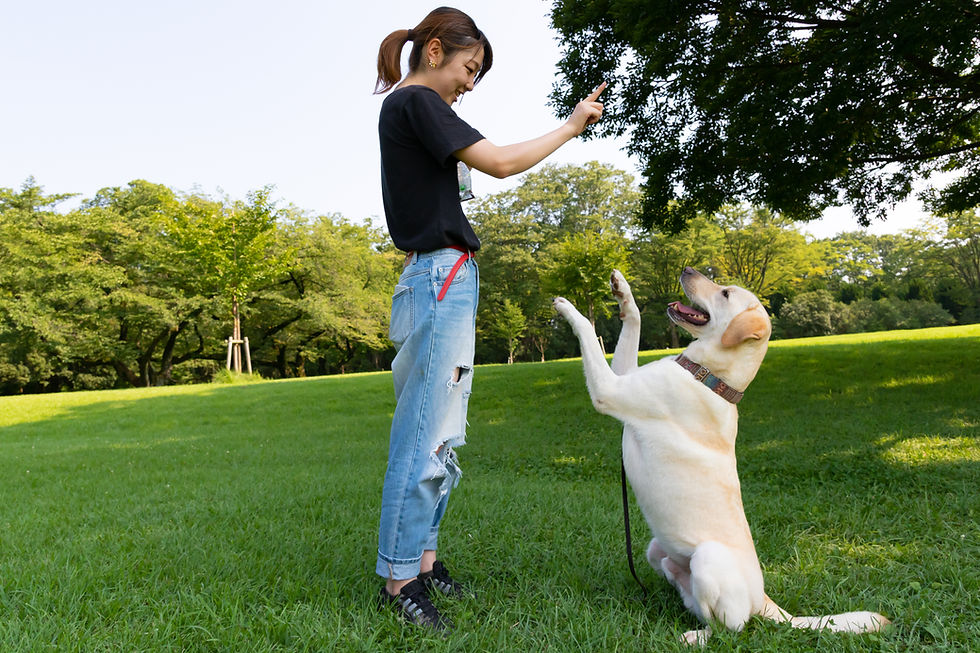Harnesses vs. Collars
- Awesome Dog Academy

- Aug 1, 2020
- 3 min read
Updated: May 17, 2021

How do you feel about collars versus harnesses? Its a question I actually get quite often as a dog trainer. I thought it'd be fun to address the idea of the epic battle of harnesses verses collars!
Now personally, I happen to use both collars and harnesses. My dogs wear their collars around the house, it's where I put their tags so if they run out the front door and I cannot retrieve them, at least they can be identified. As a side note, since two out of my three dogs need special medications, I do have "Medical issues: Needs Medication" on their ID tags. (Tags are more than just for contact info! You can additionally, put your email address, or even something like "Reward for safe return"). When I take my dogs on a walk, I put them in a harness and keep the collar on as well.
Ideally, for effective training, you'll want to use both collar and a harness. By attaching the leash to the harness, we remove the strain on your dog's neck, which is especially important with smaller breeds who are prone to trachea issues. Harnesses which are fitted properly are difficult for dogs to slip out of and keep your dog securely connected.
There are so many different options for collars and harnesses, as you might have read in our previous blog post about collars. Flat collars are our recommended type of collar, along with martingales if your dog's neck and head are close in thickness. Front clip harnesses, are an excellent type of harness to use if your dog tends to pull on the leash.
Keep in mind, dogs should not be wearing collars or harnesses if they will be playing with other dogs, as dogs have been known to get caught in each other's collars, which could cause panic and injury. Harnesses have been known to catch on things or cause chafing if they are worn constantly. especially during rigorous activity like playing.
Alright, lets talk about the pros and cons of each!
Up first, Collars!
The Pros of Collars
Dogs don't notice them. Puppies are introduced to collars very young, and as such, they don't even notice that they're wearing them. Especially if it's a flat type collar.
They come in so many different styles and colors! They can be reflective, bright and colorful, covered in bling, etc.
Collars are comfy and a great way to keep your dog's ID tags and Rabies tags.
Quick release or breakaway collars can detach in case your dog gets caught on something to prevent suffocation
The Cons of Collars
Collars have been known to cause trachea damage to dogs who pull.
Some dogs have been known to be able to slip out of their collars, especially small headed dogs like Greyhounds or broad necked dogs like bulldogs.
If you have a small breed dog, it can be hard to find a collar that fits (Hint: try checking the kitten/cat section if you have a small breed puppy)
Collars can be caught on things when your dog is playing or even running through a wooded area.
The Pros of Harness
If dog harnesses get caught on something, the dog will not suffocate
Front clip harnesses are a great tool which can help with a dog who pulls on their leashes.
Harnesses come in a wide selection, just like collars.
Harnesses create less stress on the dog and owner if they do pull while on walks.
The Cons of Collars
Harnesses can chafe around your dog's elbows if they are worn constantly.
Harnesses need to be properly fitted or else they can disturb the dog's natural gait.
Harnesses need to be removed when the dog is inside or if they are playing with other dogs.
In conclusion, both collars and harnesses are wonderful tools. Your dog trainer strongly recommends using both!




Comments